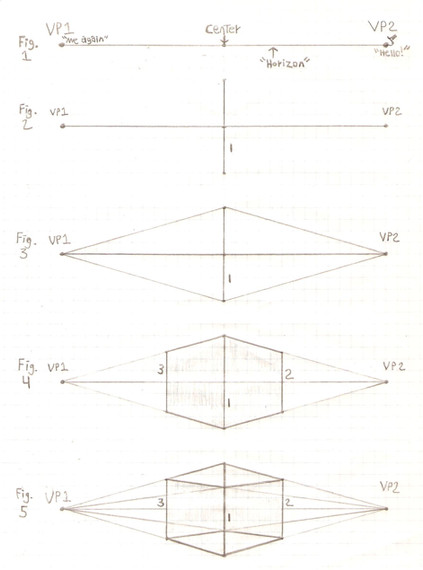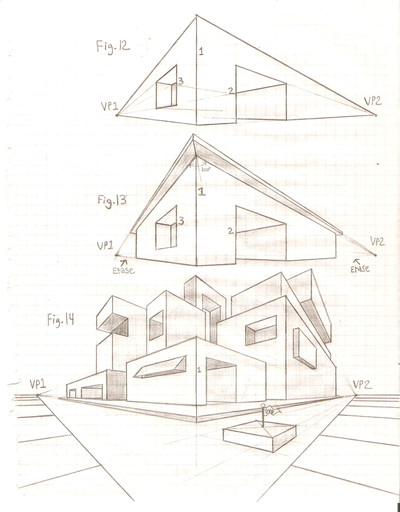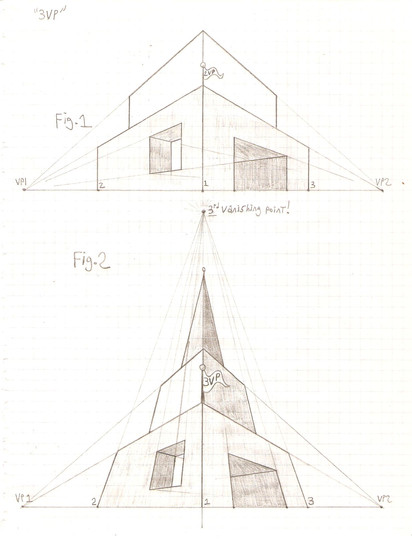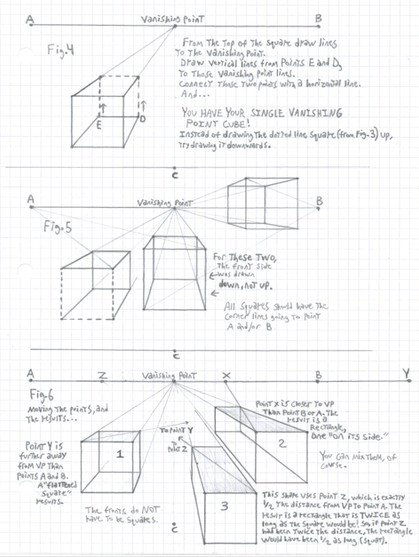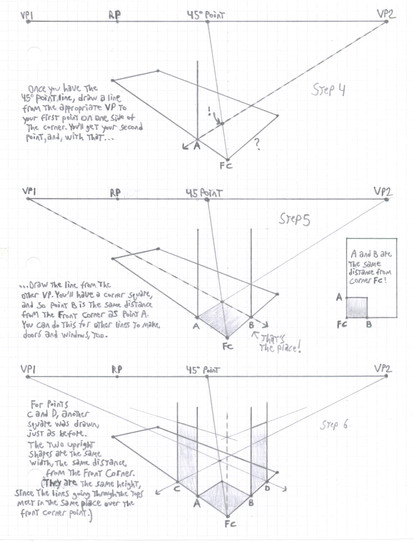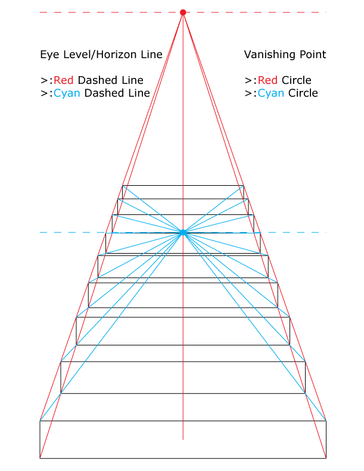HOME | DD
 GriswaldTerrastone — Perspective Tutorial: 1VP 4
GriswaldTerrastone — Perspective Tutorial: 1VP 4

Published: 2010-10-02 20:52:39 +0000 UTC; Views: 20417; Favourites: 144; Downloads: 424
Redirect to original
Description
(As a way of saying thank you to the DA community, why not contribute something, something I can give?A tutorial on perspective, perhaps?
Perspective was something that gave me plenty of trouble for years. Unable to take any courses, I had to struggle through (this was back in the 1980s, when the Internet- in any real modern sense- did not exist). Art books often assumed you knew something already, so they were helpful only to a point.
So, here, I'm going to post one- one from the point of someone who knows what it's like to start out, but, not being a professional, cannot teach like a professional...
In other words, an "ordinary person" approach.)
-Initial comment.
Part 2!
Now that the very basics of perspective have been covered, let's do something with it- why not the classic "checkered floor," which was my first (mostly) successful effort back in that distant world of 1986?
Here we go, this time (I hope!) better prepared...
Step 1: First, draw a dot. This is your vanishing point.
Somewhere below the vanishing point, draw a horizontal line.
Drop a line straight down from the vanishing point to the horizontal line. Where they meet is Point C; in this case, that center line is 7 cm.
From Point C, on both sides, draw dots. Make sure that they are the same distance apart (I put them 3 cm apart).
Now, connect each of those points to the vanishing point.
Finally, draw a horizontal line through the vanishing point; this is the "Horizon." How far to each side? Exactly as far as Point C is from the vanishing point. This is very important!
(Note: "The Horizon" is usually the level of your view, and it assumes that you are looking straight ahead. If you draw a block and it is below the horizon then you will be able to see the top of the block; if it is above the horizon then you will see the underside of the block; if the top of the block is exactly as high as the horizon then it will be perfectly level with your vision.)
For Step 2, from one of the lower corners, draw a diagonal line to one of the ends of the top horizontal lines, as shown in the illustration. From Point C, do the same thing to the same point as before.
See where the long diagonal line from the lower corner goes through the other lines? Those points will be where you draw the new horizontal lines!
Notice how the angled line from Point C gives you the same horizontal line? And how it happens to be 45 degrees, as if drawn from the corner of a square? Drop a line down from Point A, and you'll get a square!
Step 3: Draw the new horizontal lines based on that long diagonal line. To go beyond that, draw another angled line from the center line, as shown; where it goes through the lines are where the horizontal lines go.
Just as shown. You have a checkered floor!
By the way, did you notice how the second angled line from the center line is not 45 degrees, but rather 36 degrees? This is because that line must end in the same point as before, in this case Point A. This is really important to remember!
For other floors, you could use Point B, and the opposite lower corner, if you'd like...or both. Or use lines from the center lines...or a combination. But they should all give the same horizontal lines.
(Note: Since the horizontal lines are the same distance apart with this method, you could apply this part to drawing a corridor with its sections each the same size, if you wish. Since this advancement did not occur in a neat orderly fashion, I drew those corridors elsewhere in the 1 VP section before figuring out this part.)
On to...Step 4!
Next page:
[link]
Related content
Comments: 17

What if I want my horizon to be tilted? (E.g. as observed from a tilted aeroplane's cockpit.)
Or what will happen if my point A is a bit higher than the horizon, and the point B is lower?
How does it affect the image?
👍: 0 ⏩: 1

If you mean as if viewing this from a tilted airplane, all you really have to do is tilt the image above. One way is to sketch the above, tilt the paper, then put a level piece of paper over it and trace. You'd have your tilted horizon and checkered floor.
If you raise Point A and lower Point B, evenly, you'd have a tilted horizon- but the lower "horizon" would have to be tilted the same way; those two lines should be parallel. The center line should be perpendicular to both horizons in this case.
To better understand this, imagine being in an airplane that's tilted flying over the level scenery- now imagine your airplane being level, but the scenery has all tilted. You'd see the same thing.
👍: 0 ⏩: 0

Why do the points A and B need to be at the same distance from the VP as the bottom line is from the VP? What would happen if they won't?
👍: 0 ⏩: 1

That's explained a bit later on- they have to be the same distances to give you a checkered floor with squares. Changing these measurements will give rectangles. Try it yourself; quickly sketch the above as shown- then in a second sketch make A and B closer to the Vanishing Point- see what happened? Put them farther away, and the opposite happens!
That's handy to know if you would prefer checkered floor with rectangles instead of squares.
Good luck!
👍: 0 ⏩: 0

Oddly enough, I cannot remember these kinds of lessons- but I hope this puts it all together, so if there are any other artists here having trouble with this, they won't have to re-invent the wheel.
👍: 0 ⏩: 1

That's true! ^^
Good to know where to find these tips now!
👍: 0 ⏩: 1

Strangely enough, I had to abandon the next part as it was because of something that hasn't happened in years- my style advanced by a leap!
I finally figured out the "missing part" of the two/three vanishing point style just yesterday, and while it doesn't cover everything, last night I was able to properly sketch several things I couldn't do just the other day!
It was great!
THAT is one of the things that makes the DA so terrific- interaction gets the rusty gears going again!
👍: 0 ⏩: 1

I'm horrible doing perspective
thanks for the tutorial!
x~
sorry my bad english!
👍: 0 ⏩: 1

Has this tutorial been any help to you so far?
👍: 0 ⏩: 1

hehe.. you don't know how much this is helping me... thanks a lot
I know there are many things about that in the internet but I'm too lazy to hunt good tutorials
x~
sorry my bad english!!
👍: 0 ⏩: 1

I'm glad to hear that!
The next part will likely involve the two and three vanishing viewpoints. If you want to draw a large building from the viewpoint of a bird or helicopter hovering over it at an angle, for example, you'd need three- two for the top, and the third for the part going down.
I tried to find a "formula" for that, but couldn't. Guess for the most part, well, just have to get it to "look" right.
Vanishing points would also be for a "subjective" viewpoint. In the pictures with the Golem-Lin or Golem-Mice, for example, it's always "objective;" that is, it's seen from the viewpoint of something hovering nearby. But to show the Golem-Mice or the Golem-Lin from their opponents' view, or the relatively large folks from the point of view from the Golem-Mice or Golem-Lin position, is something vanishing points are needed for. I might try it.
But first- I must finish my StupidFox entry!
👍: 0 ⏩: 1

I will wait you finish
Thanks again for the tips
x~
sorry my bad english..
👍: 0 ⏩: 1

It should be even more informative- yesterday, my style there advanced! That hasn't happened in years!
DA really is getting the gears going like nothing since 1986!
👍: 0 ⏩: 1

wow! That's amazing!
I'm really happy for you
👍: 0 ⏩: 0

There are just a few basic laws of perspective- if you know them, even complicated images can be broken down:
1) Objects of equal size, as they are more and more distant, seem to get smaller and smaller,
2) Objects that are equally-spaced, as they are more and more distant, seem to be closer and closer together, and,
3) Parallel lines, as they go off into the distance, seem to come together, converge.
Honest! If you keep that in mind, more than half of what you need to know is there! If only I'd realized that back in 1980...
👍: 1 ⏩: 0
